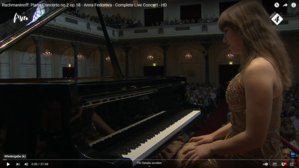The culture speaks for itself:
The reason for this article is Vladimir Putin's statements about the allegedly disgraceful treatment of Russian culture in the West. In particular, the name Sergej Rachmaninoff mentioned is reminiscent of the elaborate preservation of the concert grand piano from his summer residence "Senar" in Hertenstein on Lake Lucerne, which the author was entrusted with a few years ago. It was particularly important to preserve the composer's special requests - such as the iron-wound bass strings instead of copper and the exceptional increase of the weight of touch - in unchanged condition for posterity. The instrument is playable, but due to age-related material changes - like all other instruments of this age - no longer suitable for concerts.Therefore, the proposal was made to equip a new instrument of the same design (Steinway D) with the same specifications for this purpose.

The Steinway grand piano of Sergei Rachmaninoff in his villa "Senar"
In the tempered tuning of the grand piano, two alien systems of order confront each other, which can be characterized as mathematically rational and mathematically irrational. The series of naturals of each individual string is based on integer multiples of the fundamental frequency, while the semitone intervals, starting from the concert pitch a', are based on the factor 12√2. The only thing they have in common is the so-called octave with a frequency ratio of 2/1, which the Greeks called harmonia.
When tuning, the intention is to place both systems side by side untouched. The differences - resulting fluctuations in volume - are used to measure the pitch and provide emotional content in the presentation. The pianoforte thus clearly sets itself apart from the orchestral tuning, which presents its own world with different key-characteristics that a grand piano cannot reproduce. Although there are a number of double-named keys (C sharp/D flat, D sharp/E flat, F sharp/G flat, G sharp/A flat, A sharp/B flat ), not a single one of the tones mentioned is actually heard. This is a reminder of the ordering system of the orchestra tuning, which makes it possible to at least follow mentally. The other intervals, with the exception of the octave, also do not correspond precisely. Therefore, friction and distortions with the orchestra tuning are literally inevitable. So far, the role played by Christian symbolism in all this has gone completely unnoticed. (See Video VII: How the octave got its name.)
Following is the link to Rachmaninoff's Piano Concerto No. 2, c minor, Op. 18, performed by the Kyiv-born pianist Anna Fedorova in the main hall of the Concertgebouw Amsterdam on September 1, 2013. Martin Panteleev conducted the Northwest German Philharmonic.
In the first chords, the beats are increased to a mighty rumble into fortissimo, until a whole thunderstorm seems to be brewing when the orchestra enters. The onomatopoeia does not correspond to Rachmaninoff's intention, but the analogies can be called up up to the heavy rain. In addition to the tones which form harmonies, the accompanying beats (it. battimenti) provide the intended vibration and, later on, where they are absent, relaxation and the opportunity to breathe freely - bright spots, so to speak. Music sets a good example when it comes to the special appreciation of the different. The emotional world could not be impressed with monotony either. Rachmaninoff's grand-piano shows the intention to take the contrasts to the extreme.

Please click on the image to play
Whatever is happening in Ukraine right now:
The behavior of a power-obsessed minority must not affect the esteem of a nation.
© Aurelius Belz 2022

